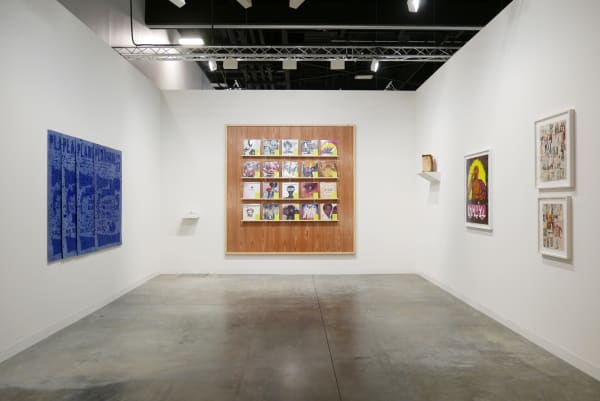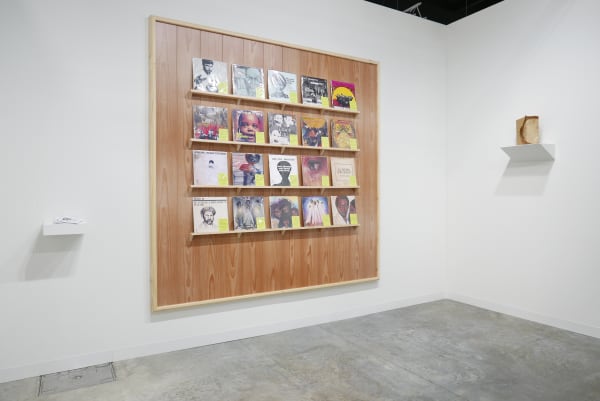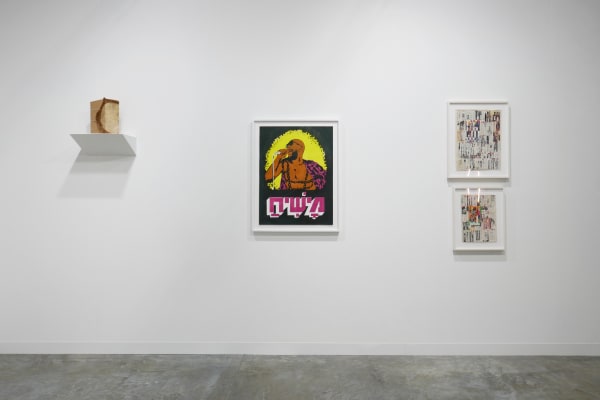For Art Basel Miami Beach 2017, Inman Gallery presents a solo exhibition of work by Houston-based artist Jamal Cyrus (b. 1973). At once an exercise in excavating forgotten histories and simultaneously imagining how others might have unfolded, Cyrus's works inhabit the potent space between truth and fiction: they present rigorous cultural criticism by embedding it seamlessly within deeply-researched historical truths.
Begun in 2005, Cyrus's ongoing project Pride Records serves as the centerpiece of the exhibition. While the imagined 1960s-era record label's early imprints include albums promoting civil rights and Black culture, by the mid-1970s, Pride began releasing a neutered series of disco records deemed politically safe and more commercially viable. The Tokyo installation of Pride Records recreates a Japanese record store's display of the vinyl treasures. The albums, displayed chronologically, are full of rich and subtle references and cross-references; Cyrus adroitly mixes found records with reworked or entirely created records. The cross-pollination of the real and the imagined makes a rich historical fiction through the lens of popular music.
Two new collages, titled Jet Auto Archive, are sourced from the artist's personal collection of Jet Magazine issues from the 1990s. These also trace a fall from the dream: like the Pride label, Jet Magazine eventually departed from its high ideals, shifting from its progressive writing about Black culture to an advertising-based model, coopting the original politics of the publication to target Black consumer power instead. In 2016, Cyrus completed a major public commission in downtown Houston in which he layered posters announcing a 1975 Lightnin' Hopkins performance at Liberty Hall. With Bobby Bland in all Blues he continues his investigation of Houston's blues history, layering the Bobby Bland concert posters and splattering them with corn grits. Cyrus's use of the ubiquitous Southern breakfast porridge has a musical history precedent: in 1974, Al Green's then-girlfriend, Mary Woodson, scalded him with a pot of hot grits before killing herself. The event prompted Green's religious transformation. For Cyrus, grits function as a material that references blue-collar food cultures of the South, and that cites art historical uses of the splatter. There is also something intentionally ritual-based in offering the great bluesmen of the past a serving of grits. Like the Boli sculptures of the Bambara people, Cyrus notes, the process of feeding these works imbues them with power. In his poster image of Isaac Hayes, Cyrus draws from a blacklight poster promoting the 1972 benefit concert WattStax in Los Angeles. Drawn with wax crayon and spray paint, the poster includes the Hebrew letters Mem, Sheen, and Het, which spell "Ma-shee-ak" or Messiah, referencing the 1960’s FBI concept of the Black Messiah. In both bodies of work, Cyrus draws rich associations between sacred or ritual processes and the communal experience of attending blues and soul concerts.
In Book sleeve prototype for W. E. B. Du Bois’s Encyclopedia Africana, a drum skin binds four volumes from the International Library of Negro Life and History, gifted to the artist by his teacher, Terry Adkins. The books further the Encyclopedia Africana project begun by Du Bois in the early 20th century as a response to the Encyclopedia Britannica. Du Bois's project was never fully realized, but he imagined it as a comprehensive compendium of Black achievement and a symbolic gesture to unify diverse communities across the diaspora. Binding or tying, in many contemporary practices throughout the African diaspora, brings a charged power to the bound object. Held by the raw leather of a drum head, this history of Black achievement is bound in Cyrus's prototype to the steady beat of music's roots. Further, in its formal relationship to a speaker-head, the leather binding suggests an amplification or broadcast of the books' contents.
Over the past two decades, Jamal Cyrus has consistently envisioned points of connection between the present and the past, between history, music, and ritual. In his work, he excavates and juxtaposes cultural moments, using materials that are densely evocative. Cyrus's work is meditation and commemoration, a distillation of political and social struggles of the past, and an exploration of how improvisation can offer potent re-imaginings of how we read history.




